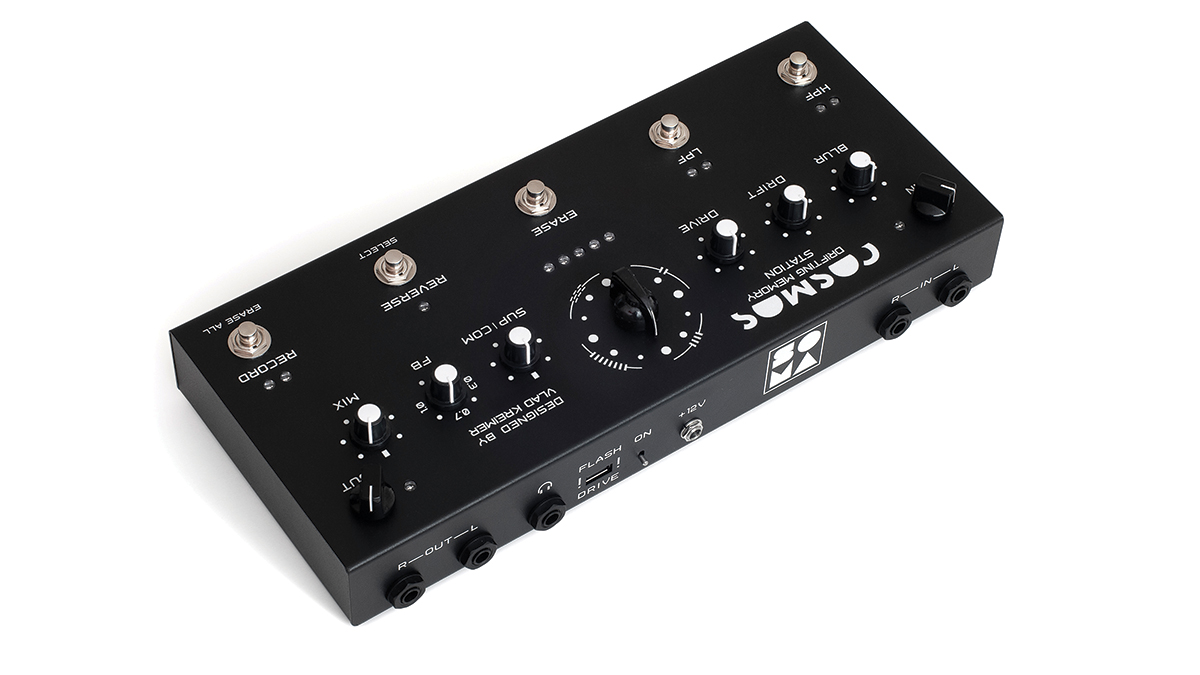Guitar World Verdict
The SOMA Cosmos is more of an instrument than an effects processor, that creates strange and beautiful sonic textures and helps musicians generate unique improvised performances of hypnotic ambient music.
Pros
- +
Generates incredibly complex, hypnotic ambient effects.
- +
Sounds evolve and mutate in unpredictable ways.
- +
Streamlined design that facilitates use in live performance.
- +
Dazzling sound quality.
Cons
- -
Not initially intuitive to use — the manual is essential.
- -
The inherent random nature of the algorithms means most effects/performances cannot be duplicated.
You can trust Guitar World
In recent years, a new variant of digital delay-based effects has emerged that is not delay as we know or understand it, yet it exists. These effects scoff at usual dotted-eighth, ping pong and multi-tap delays and boldly bluster, “hold my absinthe,” before taking musicians into a wild and wonderful world filled with strange but beautiful atmospheres.
The SOMA Cosmos is the latest entry into this category that defies previous delay descriptions. SOMA calls it a “Drifting Memory Station,” although it could just as easily be named a “Sound Alchemist’s Discovery Kit” or “Ambient Texture Mill” or such.
So what is a Drifting Memory Station, exactly? It would require a review five times the size of this entire issue to barely scratch the surface, but in essence it’s a powerful processor that employs algorithms that are exponentially more sophisticated than the norm.
These algorithms can manipulate audio signals into random patterns and truncated loops or granular segments of varying lengths, smear sounds into reverb-like textures with long, sustaining tails, crossfade effects seamlessly and much more. It’s really something you need to hear and experience yourself, as mere words don’t do it justice.
The SOMA Cosmos is about the size of an early Nineties floor multi-effects pedal, so I hesitate to call it a pedal even though it has five footswitches (High Pass Filter, Low Pass Filter, Erase, Reverse and Record) lined up along its top panel. Users can control it hands-free with their feet, but it’s also very expressively satisfying to control the unit with one’s hands on a desktop or mounted on a stand above the floor.

Cosmos is sort of an advanced looper pedal, but instead of merely playing back phrases recorded into the unit, it mangles them in delightful ways. The 12-position rotary algorithm selector knob at top center is the key to how Cosmos processes audio.
Algorithms consist of three “two delay” algorithms where two delay lines shift in place with total repetition times of about 2.5, 9.5 or 22 seconds, three “four delay” algorithms that are similar to the previous but with double the amount of delay lines, three “giant reverb” algorithms with “huge hall,” “super-huge hall” and “insanely super-huge hall” settings and three “granular delay” algorithms with small, medium and large delay and grain sizes that chop audio signals into random, asynchronous segments.
Blur and Drift knobs provide cross-feedback or modulation (except on the reverb algorithms where they are disengaged) to further mangle the sonic textures, while Drive adds smooth distorted grind. The Sup/Com control either suppresses previous sounds as new sounds are layered when the knob is turned left of 12 o’clock, or compresses the sound when turned right of 12 o’clock. Other controls consist of feedback, mix and input and output level knobs.

The rear panel is surprisingly streamlined for a processor this sophisticated, providing pairs of stereo ¼-inch input and output jacks, a headphone output jack and a USB port for downloading firmware updates via a flash drive only (not for connecting to a computer). An included 12-volt DC adapter delivers power to the unit.
The SOMA Cosmos is unlike any other effects processor on the market. It is truly an instrument unto itself that works its magic with any electronic audio source, including electric guitar or bass guitar, keyboards, drum machines or mic'd vocals. Musicians who are into creating ambient soundscapes can build long careers using this device to generate anything from John Cage-style soundtracks and Brian Eno-inspired exhibitions to live performances for a chill-out room at a rave.
Some potential users may bemoan the lack of MIDI for syncing to drum machines, loopers or synths, but that’s kind of the point. The SOMA Cosmos is more likely to deliver off-kilter 9/8 “dance kryptonite” rhythms and such without ever coming close to 4/4 monotony. If that sounds like your cup of mushroom tea, get ready to take a deep, hearty gulp.
Specs
- PRICE: $649
- TYPE: Drifting memory station / looper pedal
- CONTROLS: Input level, Output level, Blur, Drift, Drive, Suppressor/Compressor, Feedback, Mix
- SWITCHES: 12-position rotary algorithm selector, power on/off
- FOOTSWITCHES: High Pass Filter, Low Pass Filter, Erase, Reverse, Record
- CONNECTIONS: ¼-inch L and R input, ¼-inch L and R output, ¼-inch headphone output, USB (flash drive only), 12VDC power
- CONTACT: SOMA Laboratory
Chris is the co-author of Eruption - Conversations with Eddie Van Halen. He is a 40-year music industry veteran who started at Boardwalk Entertainment (Joan Jett, Night Ranger) and Roland US before becoming a guitar journalist in 1991. He has interviewed more than 600 artists, written more than 1,400 product reviews and contributed to Jeff Beck’s Beck 01: Hot Rods and Rock & Roll and Eric Clapton’s Six String Stories.
“The musicians, shops, and brands who use Reverb have always been at the center of all that we do”: Reverb has been acquired by two new investors – and will once again become an independently operated company
"A guitarist's ticket to easier home recording": PreSonus Quantum HD 2 review
Weezer’s first show was opening for Keanu Reeves’ band Dogstar. Now the John Wick star is set to play a villain in the Buddy Holly hitmakers’ forthcoming mockumentary












